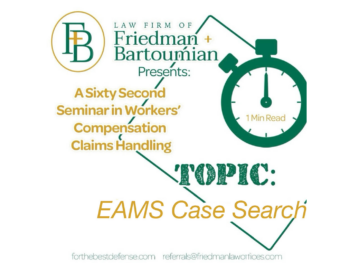There are times when an employer is uncertain if a claim should be filed when a worker claims injury, especially when compensability is in question.
Employers are often advised by their administrator that when in doubt, err on the side of caution by submitting an Employer’s First Report of Industrial Injury form, knowing that the claims administrator will review the report and thereafter determine if a claim file should be set up.
In theory such advice makes sense, but in the real world it doesn’t quite work that way. At most claims offices the clerical staff immediately set up files the moment an injury report is received, with standard claims acknowledgment letters, DWC-1 claim forms and MPN instructions mailed out to the claimant before the assigned adjuster ever sees the file.
Unfortunately, it is then too late for the adjuster to determine if a file should be created since one already exists. The only action remaining is for the adjuster to decide if the liability is to be accepted or denied. The purpose of today’s blog is to provide guidance to claims administrators by explaining why it is important not to be in such a hurry to create a file.
Case in point: Five workers for the same company were assigned to work for one week at a construction site located over 60 miles away. Instead of providing hotel rooms, the employer chose to pay everyone extra mileage to commute back and forth to the construction site each day. On the very first day after work one of the five employees decided to go out drinking. Having done so to the point of being too inebriated to drive home, the employee decided to rent a room at a local motel. While at the motel he then took a dip in the pool, whereat he lost consciousness and drowned.
The following morning the employer phoned his insurer and was told to submit an Employer’s First Report of Injury where the company would decide if a file should be created. Of course, upon receipt of the employer’s report the clerical staff followed standard procedure by immediately setting up a file and mailing out correspondence to the widow, all before the assigned adjuster ever reviewed the file.
A claim for death benefits now existed that should have never been created. Yet, because of correspondence received from the insurance company, the widow now expected to be paid workers’ compensation death benefits as she believed the insurance company would never have created a file unless the death was industrial.
Liability was eventually denied which prompted the widow to retain legal counsel to initiate litigation. All this trouble was for nothing, simply because it was the insurance company’s policy to swiftly create files immediately upon receipt of an Employer’s First Report of Injury.
Unfortunately, this was not an isolated instance. In our experience, many claim files are needlessly set up, even though liability should have been denied ab initio.
We at Friedman + Bartoumian are here to assist if uncertainty exists over the creation of a claim file. We urge administrators to reevaluate their claims set-up procedures to avoid situations like the ones described in today’s blog. When in doubt, contact F+B. Had the claims administrator in the drowning case contacted us, we would have instructed them not to set up a file. We also would have recommended not sending out any correspondence, including a DWC-1 Claim Form, as no action was necessary pursuant to the Supreme Court’s decision in the Honeywell case. The administrator learned a costly lesson when they eventually settled the drowning case for $200,000. Their haste in setting up a claim file ending up costing them dearly.


Leave a Reply